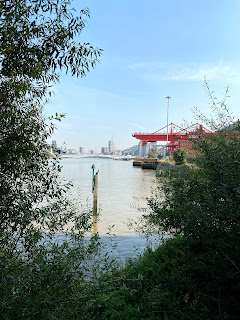My current Wandle Wardrobe focus - making clothes from the fabrics I found dumped by the nature reserve - might seem like a slightly flimsy excuse for dressing up and taking outfit photos. And it is! But I also want these clothes to be a visual aid for the stories that need to be told about our local wildlife: stories of hope, of resilience, of the changes we can make that improve the environment for its human and non-human inhabitants.
I currently own three guides to the Wandle; published in 1924, 1974 and 1997. The first two tell a depressing story about the river: in 1924 John Morrison Hobson writes: “The little river Wandle appeals to all who love the face of Nature” and lists twenty one species of fish as “denizens of the Wandle.” But by 1974, the Wandle Group are telling a horror story of sewage works and factories discharging their overflows into the river, and write sadly: “it is doubtful whether the Wandle could now support any of the larger species of fish which gave the river its reputation… that the Wandle provided as good angling as anywhere in the country”. A gleam of hope can be found in the 1997 guide, with surveys showing gradual improvements in fish populations, although they were still threatened by intermittent pollution.
Although 2020 has been a tough year for us all, it doesn’t seem to have been too bad for the fish in the Wandle; they were leaping from the water to catch insects just a few feet from where these photos were taken. The dwindling daylight hours and falling temperatures don’t seem to deter the anglers, dotted along the banks of the Wandle like living statues as the rest of us walk or run or cycle along the trail. But this outfit draws inspiration from another species of fisherfolk: the cormorant.
The Cormorant Jacket is made from just over one metre of black viscose crepe. I wanted to create something with a dramatic sleeve, to reference the way a cormorant stretches out its wings to dry them after diving. Practicality (I can’t wear long dangling sleeves at work) met necessity (there wasn’t enough fabric to make a longer sleeve), and resulted in this pleasing cape-like shape. I also wanted to evoke something of the cormorant’s sinuous neck in the shaping of the neckline and front fastening.
I have seen cormorants on every part of the river, from Grove Park and Waddon Ponds to the mouth of the Wandle where it meets the Thames at Wandsworth. If they weren’t finding food, they wouldn’t be visiting, so an inland population of these coastal birds suggests that the fishing must be good for birds as well as humans.
All beings in an environment rely on one another in complex ways, so when we improve the environment for one species, we encourage other visitors to make their homes there too: Hobson’s 1924 guide makes no mention of cormorants, or egrets (see previous post). The Wandle certainly appeals to nature-lovers again, and it’s never been more important than this year, when our daily walk was, for many of us, our only chance to get out and about for several months. I hope that as we’ve relied on our local green spaces during lockdown, we’ve also started noticing and appreciating our non-human neighbours, and caring about their welfare. We’re only going to be able to reverse the decline in wildlife populations if enough people notice the wildlife is there in the first place.






No comments:
Post a Comment